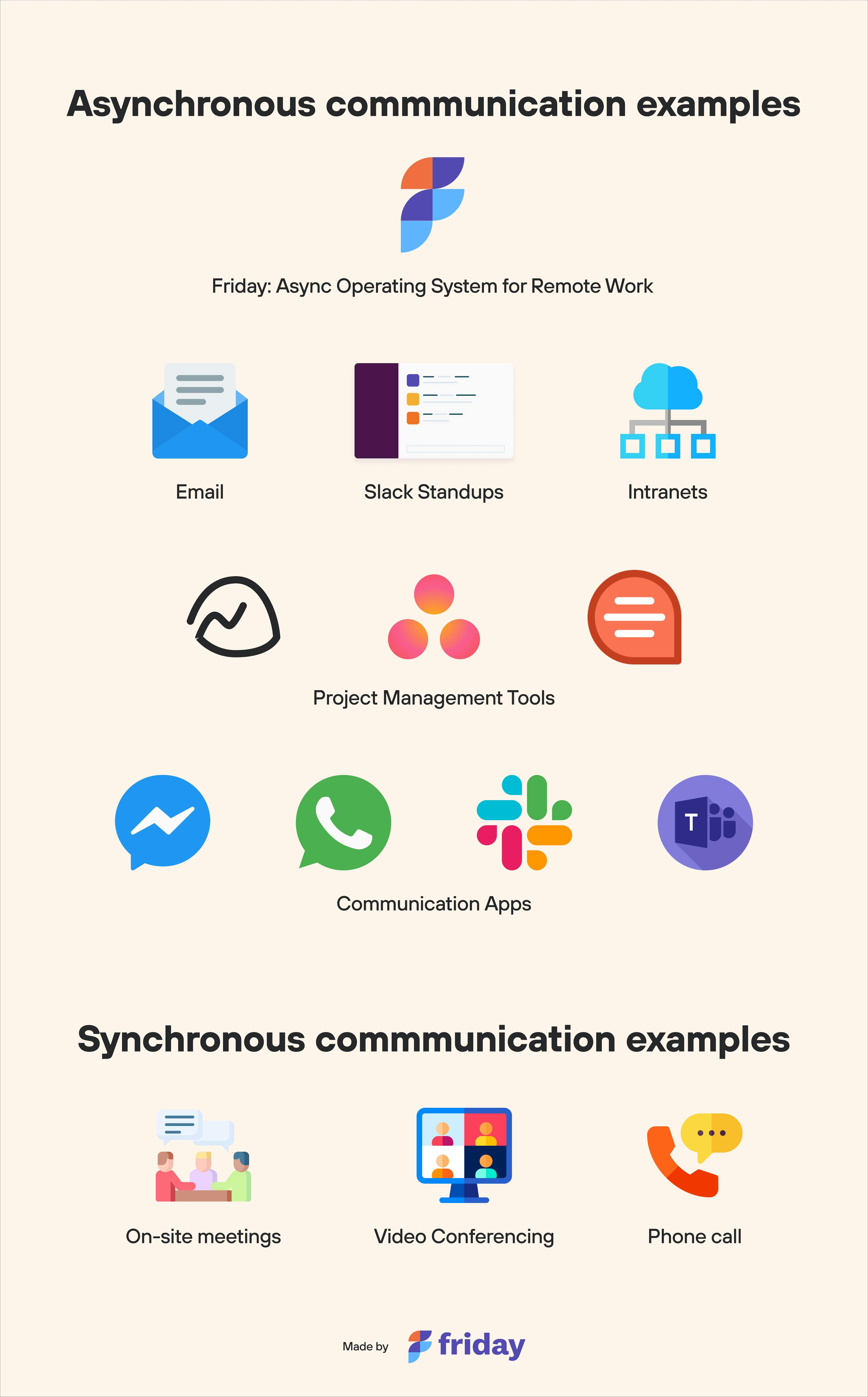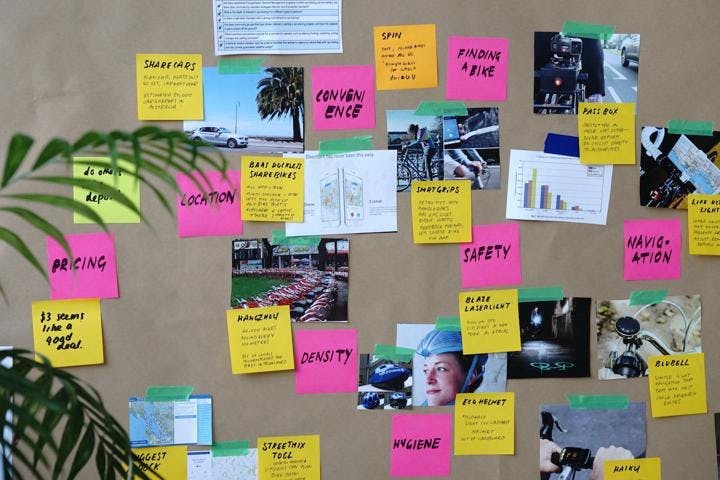Asynchronous Communication: What You Need To Know

The remote team at Friday spends most of its day with asynchronous communication - it's something we take for granted.
We believe this form of communication when coupled with traditional methods i.e. synchronous communication can give teams superpowers and unlock more productive teams. Let's dive in.
What is Asynchronous Communication?
Asynchronous communication is when two (or more) people can communicate without the requirement that they be “present” at the same exact moment in time.
Think about a meeting at work. The people who attend the meeting need be present (in a specific location) at the same exact moment in time for team productivity. Otherwise, the meeting doesn’t happen. This meeting is an example of synchronous communication.
Synchronous communication is real-time communication when two or more parties are talking or exchanging messages at the same time.
Asynchronous communication tools:
- Asynchronous messaging: Email, Facebook Messenger, Intercom, WhatsApp
- Project management tools: Basecamp, Quip, Asana,
- Async video: Loom, Prezi, Vidyard
- Intranets: Yammer, Sharepoint
See our recommendations for more asynchronous communication tools.
In these examples, one person can communicate in a way that doesn’t require the other person to be present at the same moment in time. For example, if you send me an email, I can read it later and reply. That's asynchronous work.
The internet has made asynchronous communication possible; you probably use async communication a lot more than you think.
Synchronous communication examples:
- An on-site meeting for work
- Zoom, Skype, or another form of video conferencing
- A phone call
In these examples, people must be present at the same moment in time, even if it is remote communication. This isn't rocket science.
Now that the basics are done, let's dig into how asynchronous communication can improve work.

Asynchronous vs Synchronous Communication
A friend recently recorded a conversation about asynchronous vs. synchronous communication that we wanted to share. He refers to the difference as "my time" vs. "our time." I think this is a wonderful analogy.
He defines "my time" as asynchronous communication. Examples include an email, video recording, or composing a document.
"Our time" on the other hand is when both people have live or real-time communication, such as in Slack (though this can be async as well), video conferencing, phone chat, or a team meeting.
What are the benefits of asynchronous communication?
1.) Flexibility when you can respond
The most obvious benefit of asynchronous communication is that it gives more flexibility for responses. For example, a major benefit to remote work is that it allows people to manage conversations around a "flow state." If I'm in a state of flow and someone sends me an email, I can reply after I'm done.
This is especially helpful for people on a maker's schedule; being able to manage communication around the work itself can improve productivity significantly.
One quick note: if people are using a form of async communication (email, Slack, etc) and expect an immediate response, it destroys the value of this form of communication. Many workplaces operate this way, which is unfortunate. The best remote companies will understand that this doesn't usually happen and will plan accordingly.
2.) Communication is saved by default
Imagine for a moment if your email inbox didn't have any past emails in it. In some sense, that's how synchronous communication works. Communication happens, and there's no documentation that exists (unless someone takes notes).
Asynchronous communication (especially the stuff online) is documented by default. For example, if I send an email, the record exists and can be referenced years from now. Written communication is great for that.
Once again, this is obvious, but incredibly powerful as it creates a running log of communication that happens at work that can be referenced over time . Many teams use a knowledge management or wiki as a best practice. It serves as a form of communication redundancy.
3.) Async communication can be more honest
How often have you seen a Twitter or Facebook conversation get nasty? It's amazing what people will say when there's a bit of abstraction that exists; it causes a new level of honesty, sometimes going too far the other way. This is technically called the online disinhibition effect .
For some people, it's easy to be honest in a 1-1 meeting with their manager, but for others, they hate being put on the spot. Asynchronous collaboration improves your teamwork because of the higher quality feedback. If you're a manager and you aren't collecting feedback in an async manner, you're missing out on a lot more data and insights especially with a remote team.
If you're a manager and you aren't collecting feedback in an async manner, you're missing out on a lot more data and insights especially with remote workers.
There's no doubt that asynchronous communication has emerged as even more important with remote work. It's probably the main way your distributed team communicates. There are a few downsides to asynchronous communication. It does need to be balanced with synchronous communication as well.
Downsides of Asynchronous Communication
Asynchronous communication will not solve all your problems. In fact, it can create new problems that you need to deal with.
The biggest problem is that it can be easy to be misunderstood as it lacks the richness and it can take longer to resolve these issues.
Ways you can reduce miscommunication
1. Wait to respond
2. Seek clarification
3. Use emojis & gifs (seriously!)
5. Swap out the communication channel. You may need to switch to synchronous remote team meetings sometimes.
Here are more tips on reducing asynchronous miscommunication.

How Do You Balance The Synchronous / Asynchronous Workflow?
Asynchronous communication is not going to solve all your workplace communication woes. Like most areas of life, finding a balance is key.
For example, there are times when you might be communicating over Slack with your fellow remote workers and you feel like you're not making any progress. They may have misunderstood what you were trying to say, which may cause conflict.
In these scenarios, we recommend jumping on a video or phone call.
A major advantage to synchronous communication is that it gives you more data points to observe and process the message. That's an advantage of a conversation.
For example, it's tough to understand body language over an email or Slack, while it's easier to tell in-person.
Synchronous communication is also helpful when you need to collaborate quickly (like brainstorming sessions). There are certainly times when a group of people being present unlocks better insights.
Knowing when to navigate between these two forms of communication is an important skillset to have, especially as a new manager and with remote working. Otherwise, you may find yourself lost in a Slack or email thread.
However, now it's more possible than ever to have asynchronous meetings.
Why asynchronous working & communication is the key to remote work
For those who have been working from home as a result of the Covid-19 pandemic, you may find yourself spending a lot more time communicating asynchronously, as you are no longer all in the same room. In the video below, we outline why asynchronous communication is the key to working from anywhere.
- Of 10,000 surveyed, 76% want flexibility where they work, and 93% when they work
- Synchronous remote work leads to less deep work, more time spent working, fewer true focus hours, and greater emphasis on virtual meetings
- Asynchronous work allows for shorter work hours, deeper focus on quality work, and greater output while keeping a consistent flow of communication
Conclusion: Level Up with Asynchronous Communication
Asynchronous communication when used correctly can help your organization level-up in a new way. Just remember, there are times when you need an old-fashioned in-person conversation to happen too.

